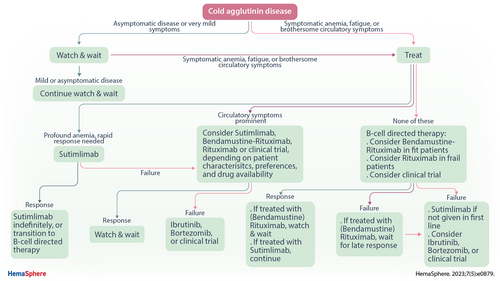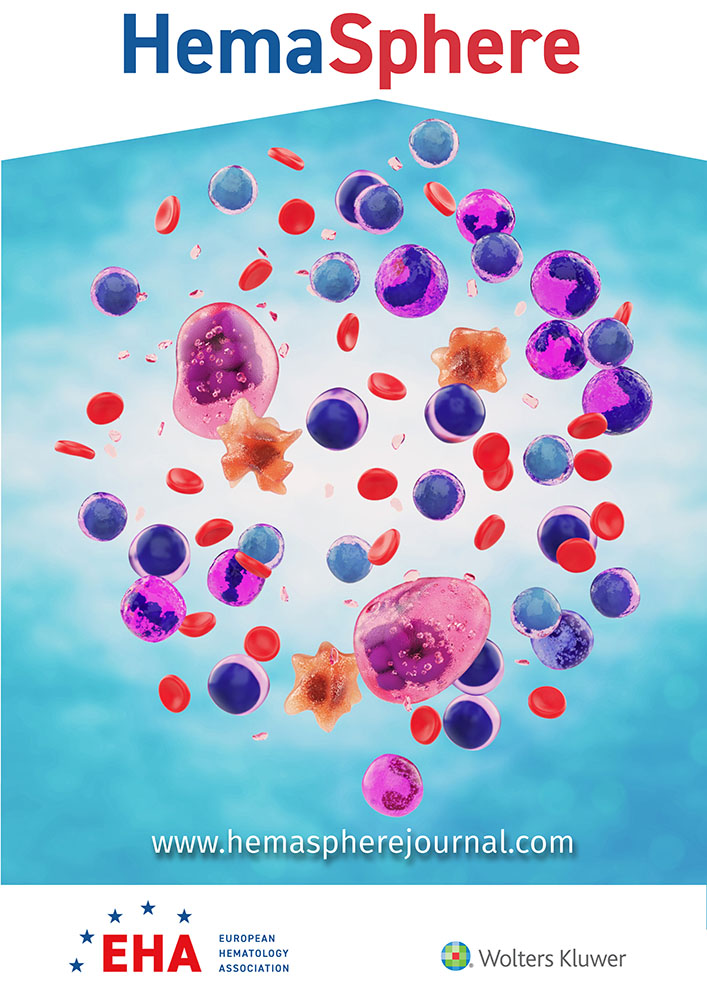Sutimlimab for the Treatment of Cold Agglutinin Disease
Graphical Abstract
Abstract
Cold agglutinin disease (CAD) is a rare autoimmune hemolytic anemia and a bone marrow clonal lymphoproliferative disorder. Hemolysis in CAD is complement-dependent and mediated by the classical activation pathway. Patients also frequently suffer from fatigue and cold-induced circulatory symptoms. Although not all patients need treatment, the symptom burden has previously been underestimated. Effective therapies target the clonal lymphoproliferation or the complement activation. Sutimlimab, a humanized monoclonal IgG4 antibody that binds and inactivates complement protein C1s, is the most extensively investigated complement inhibitor for the treatment of CAD. This review addresses the preclinical studies of sutimlimab and the studies of pharmacokinetics and pharmacodynamics. We then describe and discuss the prospective clinical trials that established sutimlimab as a rapidly acting, highly efficacious, and low-toxic therapeutic agent. This complement inhibitor does not improve the cold-induced circulatory symptoms, which are not complement-mediated. Sutimlimab is approved for the treatment of CAD in the US, Japan, and the European Union. A tentative therapeutic algorithm is presented. The choice of therapy for CAD should be based on an individual assessment, and patients requiring therapy should be considered for inclusion in clinical trials.
INTRODUCTION
Cold agglutinin disease (CAD) accounts for 15%–30% of cases of autoimmune hemolytic anemia (AIHA), making it a rare disease.1-5 The autoantibodies that mediate CAD are termed cold agglutinins (CA), referring to their ability to agglutinate erythrocytes at temperatures below central body temperature. The optimum temperature for the antigen-antibody reaction is 0°C–4°C; however, binding can also occur at higher temperatures within an individual range known as the thermal amplitude.6 At a thermal amplitude >28°C–30°C, antigen binding will take place at temperatures normally found in the acral parts of the body, and the CA will be pathogenic.6, 7 Occasionally, CA with a thermal amplitude approaching 37°C do occur.
The underlying pathogenetic process in CAD is a well-defined clonal B-cell lymphoproliferative disorder of the bone marrow,8-10 recently recognized by the World Health Organization classification of hematolymphoid neoplasms as a distinct entity but not classified as a malignant disease,11, 12 The clonal B cells produce monoclonal CA, almost invariably of the immunoglobulin M kappa (IgMκ) class.6, 13-15 Thus, CAD should be distinguished from secondary CA syndrome, a similar but heterogeneous, still rarer syndrome that occurs secondary to specific infections (Mycoplasma pneumoniae pneumonia, Epstein-Barr virus infection, cytomegalovirus infection, Severe Adult Respiratory Syndrome Coronavirus-2 infection, and others) or malignancies (typically overt B-cell lymphoma).3, 5, 7, 16
In the cooler parts of the body, temperatures within the thermal amplitude of the CA will allow binding to its erythrocyte surface antigen. Facilitated by the pentameric or even hexameric structure of IgM,17 this results in agglutination of red blood cells with impaired passage through the capillaries, which explains the frequently occurring cold-induced circulatory symptoms such as acrocyanosis, Raynaud-like phenomena, less frequently livedo reticularis, and, rarely, gangrene.14
The binding of IgM-CA to its cell surface antigen initiates the classical complement pathway by interaction of the Fc domain of the antibody with the complement protein C1q, leading to fixation of the C1qrs complex and sequential activation of the C1r and s serine proteases (Figure 1).19, 20 Activated C1s binds and splits C4 and then C2, followed by formation of C3 convertase, which binds and cleaves C3, resulting in opsonization of erythrocytes with C3b.20, 21 C3b-coated erythrocytes are prone to phagocytosis by the mononuclear phagocytic system, mainly in the liver, known as extravascular hemolysis.21, 22 On the surviving cells, further degradation of C3b leaves the cells coated with C3d, which is not recognized by the phagocytes but allows these erythrocytes to be identified in the laboratory by the direct antiglobulin test. C3b can also react with C2a and C4b to form C5 convertase, which binds and cleaves C5, thereby initiating the terminal complement cascade with formation of the C5b-9 complex (membrane attack complex) and intravascular hemolysis. Due to the intact CD55- and CD59-mediated regulation, terminal complement activation seems to be limited or even absent in CAD except in severely affected patients and acute exacerbations.20, 21, 23
Besides hemolytic anemia, some other clinical features of CAD are also complement mediated. First, exacerbation of CAD often occurs following febrile infection, major trauma, or major surgery.14, 24 This is explained by additional complement enhancement during acute phase reactions, in particular by repletion of low C4 levels that are otherwise rate-limiting for the complement-mediated hemolysis.24 Second, fatigue is common, sometimes profound, and can be present even with mild anemia, which is attributed to generation of soluble, proinflammatory complement split products (Figure 1).25-27 Third, CAD is associated with a moderately increased risk of thrombosis.14, 28-30 Table 1 shows an overview of the complement-mediated and noncomplement-mediated features of CAD.
| Complement Involvement | Disease Feature | Pathogenetic Mechanism |
|---|---|---|
| Complement-mediated features | Hemolysis | Classical complement pathway activation by Ag-Ab complex→ C3b opsonization of RBCs → mainly extravascular hemolysis |
| Fatigue | Classical complement pathway activation by Ag–Ab complex → soluble proinflammatory split products | |
| Exacerbation triggered by febrile infections, major trauma, or major surgery | Increased production of C4 (and C3) in acute phase reaction → complement enhancement→ extra/intravascular hemolysis | |
| Risk of thrombosis | Multiple points of interaction between the complement and coagulation cascades | |
| Noncomplement-mediated features | Cold-induced circulatory symptoms | RBC surface I-antigen binds IgM-CA → RBC agglutination |
| • Acrocyanosis | ||
| • Raynaud-like symptoms | ||
| • Livedo reticularis (uncommon) | ||
| • Gangrene (rare) |
- Ab = antibody; Ag = antigen; C3/C4 = complement proteins; CA = cold agglutinin; CAD = cold agglutinin disease; IgM = Mimmunoglobulin M; RBC = red blood cell.
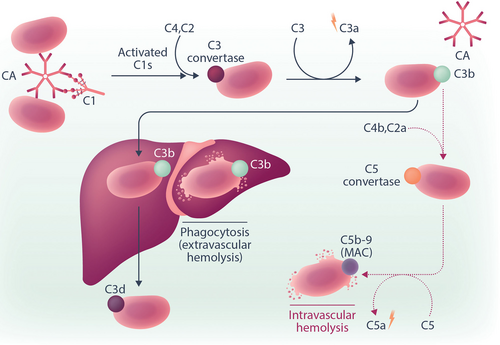
Complement-mediated hemolysis in CAD. IgM-cold agglutinin bound to its cell surface antigen initiates the classical complement activation pathway by binding and activating the C1qrs complex. Activated C1s cleaves C4 and C2 in turn; C4 and C2 split products combine to form C3 convertase on the cell surface, followed by fixation and cleavage of C3. C3b-opsonized erythrocytes are phagocytosed by the mononuclear phagocytic system, predominantly in the liver (extravascular hemolysis). To some degree, in particular in severely affected patients and acute exacerbations, C3b can also combine with C4b and C2a, thereby forming C5 convertase and activating the terminal complement cascade. If this pathway is triggered, C5 convertase binds and splits C5, resulting in formation of the MAC, and intravascular hemolysis. Lightning symbols denote anaphylotoxin properties of soluble split products. Only relevant pathways are shown. CAD = cold agglutinin disease; MAC = membrane attack complex.
Thermal protection, which remains a cornerstone in the management of CAD patients who are not in complete remission after treatment, is described elsewhere.4 Asymptomatic patients and those with very mild disease have not been shown to profit from drug therapy. However, the restrictive attitude toward therapy found in older literature seems based on an underestimation of the symptom burden as well as the poor effect of corticosteroids and unspecific immunosuppression.3, 4, 14, 31 Today, patients should be offered treatment if they have symptomatic anemia, bothersome cold-induced circulatory symptoms, or significant fatigue.3, 5, 32
The 2 major steps in pathogenesis, clonal B-cell lymphoproliferation and classical complement activation, are logical and feasible targets for therapy.18 This review will primarily address the complement C1s inhibitor sutimlimab as an extensively studied and recently established therapy option.
NONCOMPLEMENT-DIRECTED THERAPIES
Among the B-cell directed therapies, rituximab monotherapy was the first treatment shown to be effective in CAD and resulted in an ~50% overall response rate (ORR), very few complete responses (CR), and a median response duration of 6.5–11 months in 2 nonrandomized prospective studies.33, 34 Rituximab was generally well tolerated.
In another nonrandomized trial, the combination of rituximab with bendamustine administered at 4-week intervals for 4 cycles fixed duration yielded a 71% ORR with 40% CR.35 These response rates increased to 78% and 53%, respectively, on further follow-up because of some very late responses and deepening of responses over time.14 Median estimated response duration was not reached after 88 months and the 5-year sustained response rate was 77%. The median time to response was 1.9 months (range, 0.25–12 months) with even longer time to best response (median 7 months; range, 1.5–30 months). Transient grade 3–4 neutropenia occurred in 33% of the participants, but only 11% had infection, including infections without neutropenia. Twenty-nine percent had their dose of bendamustine reduced.35 Additional B-cell-directed approaches will be briefly addressed in the Future Prospects section.
SUTIMLIMAB: BASIC PROPERTIES AND IN VITRO STUDIES
Sutimlimab, previously known as TNT009 or BIVV009, is the first complement classical pathway inhibitor studied in patients with CAD. This IgG4 humanized monoclonal antibody inhibits the classical pathway at an upstream level by binding and inactivating C1s, thereby preventing the activation of C4 and C2.21, 36, 37 Each heavy chain of sutimlimab is composed of 445 amino acids and each light chain of 216 amino acids, resulting in a molecular weight of ~147 kDa.37, 38 As opposed to IgG3 and IgG1, IgG4 does not activate complement by itself.39 The specificity of sutimlimab for C1s implies that only the classical activation pathway is inhibited, while the lectin and alternative pathways are left intact.
Understanding the mode of action of sutimlimab is based on in vitro experiments with TNT003, a corresponding anti-C1s mouse monoclonal IgG2 antibody.21, 40 In studying the antihemolytic effects of TNT003 in the presence of plasma from 40 CAD patients as a source of CA and normal human serum as a source of complement, TNT003 was shown to prevent deposition of C3 fragments on erythrocytes and abrogate hemolysis at the same concentration of the drug (Figure 2).21 TNT003 also prevented erythrophagocytosis by a phagocytic cell line and stopped the CA-induced generation of the proinflammatory complement split products C4a, C3a, and C5a.
Another in vitro study compared the mode of action and efficacy of the humanized and the murine variants of the anti-C1s antibody by assessing their inhibitory effect on HLA-antibody-induced classical pathway complement activation downstream of C1.41 The results demonstrated that sutimlimab as well as TNT003 were highly effective in blocking C3 and C4 activation at concentrations >20 μg/mL in both solid phase and cellular assays.
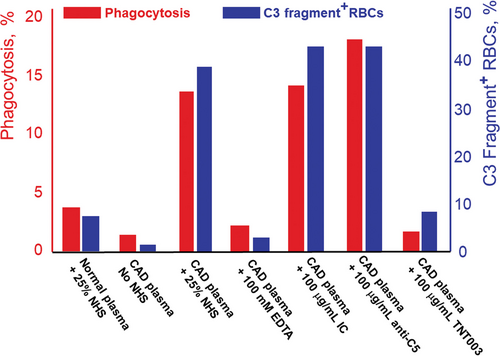
In vitro inhibition of cold agglutinin-induced, complement-mediated phagocytosis and C3 fragment deposition on erythrocytes by TNT003 (anti-C1s mouse monoclonal antibody). Plasma samples from CAD patients were used as a source of cold agglutinin and normal human serum as a source of complement. Based on data from Shi et al.21 Figure previously published by Berentsen et al,36 reused under a Creative Commons Attribution (CC BY) license (https://creativecommons.org/licenses/by/4.0/). Copyright (2022): Berentsen et al. CA = cold agglutinin; CAD = cold agglutinin disease; EDTA = ethylene diamine tetraacetic acid; IC = internal control; NHS = normal human serum; RBC = red blood cell.
PHARMACOKINETICS, PHARMACODYNAMICS, AND METABOLISM
The relevant studies of complement C1s inhibition are listed in Table 2. In a phase 1 trial, the pharmacokinetic and pharmacodynamic properties of sutimlimab were assessed along with safety and tolerability in healthy volunteers.42 At doses between 60 mg/kg and 100 mg/kg, peak serum concentrations were achieved at the end of a 60-minute infusion, and mean maximum concentration increased proportionally with the dose. Mean half-life in serum ranged from 19 to 132 hours and increased with higher dose levels. A single infusion within a 3–100 mg/kg dose range suppressed classical complement pathway activity by >90% within 60 minutes after start of infusion. The duration of suppression increased proportionally with the dose, from 8 hours following a 3 mg/kg dose to 14 days at a dose of 100 mg/kg. At doses >60 mg/kg, constant C1s inhibition was achieved with a 14-day dose interval,42 which was confirmed in a named patient program.44 Evidence of antidrug antibodies against sutimlimab was found in 6%–8% of the study participants, in some cases even before they had been exposed, but did not affect the functional activity of the study drug.42
| Publication (Reference) | Study Drug | Phase | Study Objects | N | Study Design | Main Findings |
|---|---|---|---|---|---|---|
| Shi et al21 | TNT003 | Preclinical | CAD serum samples | 40 | In vitro experiments | Study drug inhibited classical pathway activation, C3b deposition, and hemolysis. |
| Bartko et al42 | Sutimlimab | 1 | Healthy volunteers | 48 | Prospective, placebo-controlled | Cmax after 1 h following 60–100 mg/kg doses. Suppression of classical pathway by >90% within 1 h. Duration of effect 14 days after 100 mg/kg. Study drug was well tolerated. |
| Jäger et al43 | Sutimlimab | 1b | Patients with CAD | 10 | Prospective, uncontrolled | Hb increased by ≥2 g/dL in 7/10 patients. Median Hb increase was 1.6 g/dL by wk 1 and 3.9 g/dL by wk 6. No drug-related SAE. |
| Gelbenegger et al44 | Sutimlimab | - | CAD patients who already responded to sutimlimab | 7 | Follow-up of Jäger et al 201943 [above] | Effect of sutimlimab was rapidly restored when restarted after discontinuation. Hb levels were maintained except for a few events of breakthrough hemolysis at low doses, successfully managed by dose increase to 5.5 g (fixed). No drug-related SAE. |
| Röth et al (CARDINAL)26 | Sutimlimab | 2/3 | Transfused patients with CAD | 24 | Prospective, uncontrolled | Hb normalized or increased by ≥2 g/dL without transfusions in 13/24 patients. Hb increased by ≥1 g/dL in additional 7/24 patients. Fatigue scores greatly improved. Study drug was generally well-tolerated. No drug-related SAE. |
| Röth et al (CARDINAL extension)45 | Sutimlimab | 2/3 | Previously transfused patients with CAD; follow-up of above study | 24 | Prospective, uncontrolled | Responses achieved in CARDINAL study (row above) were sustained after 1 y. No new safety concerns were noted. |
| Röth 2021 (CADENZA)27 | Sutimlimab | 3 | Nontransfused CAD patients with Hb ≤ 10 g/dL | 22 + 20 | Prospective, placebo-controlled, randomized | Hb increase of ≥ 1.5 g/dL was achieved in 16/24 in treatment arm; 2/20 in placebo arm. Fatigue scores improved greatly in treatment arm but not in placebo arm. Bilirubin normalized within 1 wk in treatment arm. No new safety concerns were noted. |
| Röth 2022 (CADENZA extension)46 | Sutimlimab | 3 | Follow-up of the above study after initiating sutimlimab in the placebo group | 22 + 20 | Follow-up after randomized study | Effect and safety of sutimlimab were sustained for >79 wk on continued medication. Patients in the placebo group were given sutimlimab after wk 26 and rapidly achieved remission. |
| Gelbenegger et al47 | Sutimlimab | - | CAD patients already successfully treated with sutimlimab | 4 | Prospective, uncontrolled extension study | Hemolytic anemia recurred in all patients during washout. Remission was immediately restored after re-initiation of therapy and sustained throughout the study (mean 52 months). Adverse effects were not observed. |
- Cmax = maximum concentration; C3b = fragment of complement protein C3; CAD = cold agglutinin disease; Hb = hemoglobin level; SAE = serious adverse event; TNT003 = mouse monoclonal IgG2 antibody against C1s.
Sutimlimab is eliminated by proteolytic degradation. Like in IgG in general, elimination is slowed down by neonatal Fc-receptor-mediated recirculation, resulting in a terminal half-life of ~21 days.48, 49 However, target-dependent disposition may cause a dose-dependent reduction in the duration of effect.37, 42
SAFETY
The safety of TNT003 and its selective inhibitory activity on the classical complement pathway were evaluated in vivo in cynomolgus monkeys.50 Despite ≥95% classical pathway inhibition as assessed by ELISA technique, no obvious safety issues were encountered.
In the above-mentioned phase 1 study,42 48 healthy volunteers received either single infusions of sutimlimab at doses up to 100 mg/kg, or 4 consecutive infusions of up to 60 mg/kg at 1-week interval, whereas 12 comparators were given placebo. Eleven subjects (31%) receiving sutimlimab experienced a total of 18 adverse events (AEs), whereas 6 subjects (50%) in the placebo arm had a total of 8 AEs. The most frequent AEs in the sutimlimab arm were headache (13%) and rhinopharyngitis (8%), none of which resulted in premature withdrawal. No drug-related serious adverse events (SAEs) were seen.42 The highly favorable tolerability was confirmed in a phase 1B trial of 10 patients with CAD.43 Premedication was not encouraged in this or the subsequent clinical studies.26, 27, 43
In the below described, prospective uncontrolled CARDINAL study of sutimlimab in 24 patients with CAD, AEs with unconfirmed association to the study drug were noted in 22 subjects (92%).26 The most common AEs (>10% each) were respiratory tract infection, viral infection, diarrhea, dyspepsia, cough, arthralgia, arthritis, and peripheral edema. Seven patients (29%) had at least 1 SAE, none of which was considered related to sutimlimab. The largest clinical trial of sutimlimab performed to date was the randomized, double-blind CADENZA study, in which 22 patients with CAD received sutimlimab and 20 patients were given placebo.27 In this trial, 21 (96%) sutimlimab patients and 20 (100%) placebo patients experienced ≥1 AE. Headache, hypertension, and rhinitis were the most common AEs and were mostly considered unrelated to the study drug. Of note, however, treatment-emergent cases of Raynaud-like phenomena (18%) and acrocyanosis (14%) were only seen in the sutimlimab arm. Three patients discontinued sutimlimab because of AEs.
In theory, upstream classical pathway complement inhibition might carry a risk of severe infection, in particular with encapsulated bacteria such as Neisseria meningitidis, Streptococcus pneumoniae, and Haemophilus influenzae type B.19, 51 Therefore, participants in all clinical sutimlimab trials were vaccinated against these bacteria (including meningococci serogroup B and meningococcal conjugate ACWY), but antimicrobial drug prophylaxis was not encouraged. Meningococcal infection or treatment-related serious bacterial infections were not seen.26, 27, 45 Furthermore, a risk of developing systemic lupus erythematosus (SLE) has been suspected based on theoretical considerations, as hereditary deficiencies in proximal classical pathway complement proteins are associated with a risk of familial SLE.52 In the clinical sutimlimab trials, however, patients were closely monitored for such AEs, but the development of lupus antibodies or cases of clinical SLE did not occur.26, 27, 42, 43, 45
EFFICACY OF SUTIMLIMAB: CLINICAL TRIALS
In a phase 1B trial, Jäger and colleagues studied the safety and efficacy of sutimlimab in 10 patients with CAD.43 Patients received a 10 mg/kg test dose of sutimlimab and a second dose of 60 mg/kg 1–4 days later, followed by weekly doses of 60 mg/kg. Seven patients increased their hemoglobin (Hb) levels by >2.0 g/dL, and median Hb increase was 1.6 g/dL within the first week and 3.9 g/dL within 6 weeks. Extravascular hemolysis was abrogated within 24 hours in most patients, as seen from normalization of bilirubin levels. Hemolytic anemia recurred 3–4 weeks after the last dose, but readministration of sutimlimab restored the control.43
The Cardinal study was a prospective, single-arm, open label trial in 24 patients with CAD, a recent history of transfusion, Hb <10 g/dL at inclusion, and at least 1 CAD-associated symptom.26 Participants received 2 doses of sutimlimab at 1-week interval, thereafter 1 dose every 2 weeks for 26 weeks. Patients who weighed <75 kg at baseline received 6.5 g per dose, while those who weighed ≥75 kg were given doses of 7.5 g. The primary end point was achievement of Hb ≥12.0 g/dL or an increase in Hb by ≥2.0 g/dL without transfusion after week 5 and without protocol prohibited medications. A stable increase in Hb of >1.0 g/dL was also considered clinically meaningful. Secondary end points were mean Hb change in the whole cohort, normalization of bilirubin and lactate dehydrogenase (LDH) levels, improvement of fatigue as assessed by the Functional Assessment of Chronic Illness Therapy (FACIT) scale,26, 53 and the number of transfusions received during the first 5 weeks on therapy.
The criteria for the primary end point were met in 13 patients (54%), and 20 patients (83%) achieved a stable increase in Hb by >1.0 g/dL. Hb levels improved significantly during the first week; and the mean Hb level in the whole cohort exceeded 11.0 g/dL from week 4 and throughout the study period. Bilirubin levels declined abruptly during the first week and had normalized by week 3. Seventeen patients (71%) received no transfusions after week 5. A clinically and statistically significant reduction in fatigue score was observed by week 1 and was maintained through week 26. Classic complement pathway activity was rapidly halted. Abrogation of hemolysis and improvement of fatigue scores coincided with the complement inhibition.26 A 1-year follow-up study confirmed sustained classical complement pathway inhibition at the C1s level in patients who had continued on sutimlimab.45 Sustained effects were also seen with regard to Hb, markers of hemolysis, and FACIT fatigue scores.
These favorable results were confirmed in the Cadenza study, a randomized, placebo-controlled double-blind phase 3 trial in 42 CAD patients with Hb <10 g/dL at baseline but no recent history of transfusion.27 In this study, the primary end point was the proportion of participants who achieved an Hb increase ≥1.5 g/dL along with avoidance of transfusion. Secondary end points were bilirubin and LDH levels, FACIT fatigue scores, and pharmacodynamics. Sixteen (73%) patients in the treatment arm met the primary end point criteria, as compared with only 2 (10%) in the placebo arm. Patients who received sutimlimab had a significant increase in Hb levels, improvement of fatigue scores, and normalization or near-normalization of hemolytic markers. Bilirubin levels normalized within 1 week in the treatment arm.27
A recently presented extension of the CADENZA study demonstrated sustained normalization or near-normalization of variables for at least 79 weeks in the treatment arm.46 Patients in the placebo arm, who were given sutimlimab from week 26, achieved an improvement very similar to the sutimlimab arm within few weeks after shift to active treatment (Figure 3).
In a follow-up study of 6 responders who had discontinued sutimlimab, all patients had an immediate relapse of hemolytic anemia after discontinuation, but complement inhibition and control of hemolysis were rapidly restored on retreatment.44 Another small prospective study aimed to determine response duration in 4 patients who already had achieved remission on sutimlimab.47 Treatment was discontinued for drug-unrelated reasons in 1 patient, but 3 patients continued for a mean duration of 52 months, including previous sutimlimab therapy. Sustained effects on Hb and bilirubin levels were observed throughout the study. Sutimlimab also prevented complement enhancement and exacerbation of CAD in a patient undergoing cardiac surgery described in a case report.54
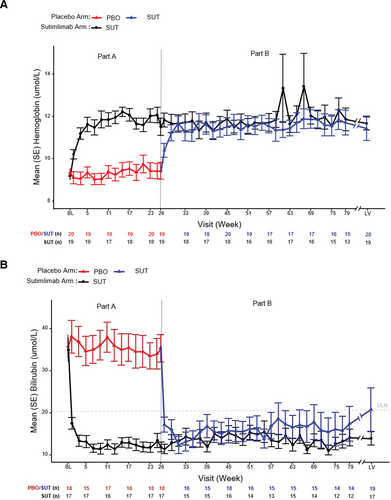
Improvement of hemolytic anemia in the randomized CADENZA study of sutimlimab in patients with CAD. Rapid normalization of hemoglobin levels (A) and bilirubin levels (B) were observed in the treatment arm. In the placebo arm, no significant improvement was observed during the first 26 wk (Part A). After 26 wk (Part B), patients randomized to the placebo arm were shifted to sutimlimab, followed by rapid improvement of hemolytic anemia very similar to that observed initially in the treatment arm. Remissions were sustained throughout the study period (≥79 wk). Figure first published in Blood by Röth, Berentsen, Barcellini et al,46 reused under general permission. Copyright (2022): the American Society of Hematology. BL = baseline; CAD = cold agglutinin disease; Hb = hemoglobin; LV = last available on-treatment value; PBO = placebo; SE = standard error; SUT = sutimlimab; ULN = upper limit of normal.
As expected, the sutimlimab studies did not show any improvement of cold-induced circulatory symptoms.26, 27, 36, 45 Furthermore, patients with >10% clonal lymphoid infiltration in the bone marrow were excluded from the CARDINAL and CADENZA trials.26, 27 Thus, the effect of sutimlimab has not been systematically evaluated in patients with a more prominent lymphoid infiltration and/or high IgM levels.
APPROVAL, INDICATIONS, AND PRECAUTIONS
Sutimlimab (Enjaymo, Sanofi-Genzyme, Boston, MA) was approved by the United States Food and Drug Administration in February 202236, 55 and subsequently by the corresponding Japanese authorities and the European Commission.56, 57 The only established indication is hemolytic anemia in CAD. In the USA, the formally approved, exact indication is to decrease the need for red blood cell transfusion due to hemolysis in adults with CAD,55 while in Japan and the European Union, the approval is not restricted to patients who need transfusion.56 The only contraindication listed in the prescribing information is known hypersensitivity to the drug.37 Patients are required to be vaccinated against meningococci (including, if available, serogroup B and meningococcal conjugate type A, C, W, and Y), pneumococci, and Haemophilus influenzae B.26, 36, 37, 58 Vaccination should be completed at least 2 weeks before the first dose of sutimlimab, or, if urgent therapy is indicated, as soon as possible. Patients who have recently received B-cell-directed therapy may have an insufficient response to vaccines.58, 59 With respect to revaccination, physicians should refer to the Advisory Committee on Immunization Practices guidelines or the national recommendations.58, 60, 61 As in any complement-mediated hemolytic disease, vaccination before the start of complement inhibition might occasionally trigger an exacerbation of CAD.62, 63 Therefore, patients should be followed closely during the interval from vaccination to the start of complement inhibition.
INTERACTIONS
Cases of interactions with other drugs have not been published, and interactions are not expected to be a big problem with this monoclonal IgG antibody. In theory, infusion of fresh-frozen plasma might reduce the inhibitory potential of sutimlimab by a competitive effect of exogenous complement. However, the use of blood products with a high complement content should probably be avoided in CAD anyway.24
FUTURE PROSPECTS
With the advent of the studies of sutimlimab, therapy for CAD has made a major step forward. As even this, highly successful therapy for the complement-mediated manifestations of CAD leaves some unmet needs, further development is warranted in both B-cell targeting and complement-targeting therapies. Among B-cell-directed approaches, the Bruton tyrosine kinase inhibitor (BTKi) ibrutinib has shown highly promising results in a retrospective series,64 and a prospective BTKi trial in CAD is warranted. Furthermore, bortezomib monotherapy has shown some benefit in a small, prospective trial, and recent results from a warm-antibody AIHA study seem to indicate that this benefit might be improved by using bortezomib in combinations.65, 66 Two cases of success with the anti-CD38 monoclonal antibody daratumumab have been reported in patients with refractory CAD,67, 68 but systematic studies have not been published.
Regarding future complement-directed therapies, candidate drugs include the C1q inhibitor ANX005,69 the C1s inhibitor BIVV020 (ClinicalTrials.gov, NCT04802057),70 the C2 inhibitor ARGX-117,71 and the pegylated cyclic peptide pegcetacoplan, an inhibitor of C3.72 Of these, clinical data are available with pegcetacoplan, which has shown favorable results in a phase 2 trial73 and is now being investigated in a phase 3 trial (ClinicalTrials.gov, NCT05096403).
CONCLUSIONS
Sutimlimab is the most extensively studied complement inhibitor to date for the treatment of CAD. This monoclonal therapeutic antibody is highly efficacious, rapidly acting, low-toxic, and represents a major improvement of the therapeutic arsenal. The main drawbacks are the lack of effect on the circulatory symptoms, the probable need for indefinite duration of therapy, and the very high costs.
Patients with CAD should be offered treatment if they have symptomatic anemia, significant fatigue, or cold-induced circulatory symptoms interfering with quality of life. Effective therapies target the pathogenic B-cell clone or the classical complement pathway. The choice of treatment in individual patients should be based on the different profiles of these approaches, individual patient characteristics, clinical disease features, and patient preferences.18, 32, 36, 74 Figure 4 shows a therapeutic algorithm.
Where available and affordable, sutimlimab should be considered in the first line if a rapid response is needed, for instance in profoundly anemic patients and in acute exacerbations that do not resolve spontaneously. If a stable response is achieved, sutimlimab may be continued indefinitely or transition to a B-cell-directed, time-limited therapy can be considered.5, 36, 75 In other CAD patients requiring treatment, rituximab plus bendamustine is still a good first-line therapy in otherwise fit patients with moderate-to-severe disease,3, 14, 35 and rituximab monotherapy remains an appropriate option for frail patients.3, 33, 34 In patients with marked or severe circulatory symptoms, B-cell-directed approaches should be preferred over complement-mediated therapies. In the second line, sutimlimab will often be the best option provided it has not proved unsuccessful in the first line and the patient does not have disabling circulatory symptoms. Finally, as still more novel therapies are in the pipeline, patients with CAD requiring treatment should be considered for prospective clinical trials.
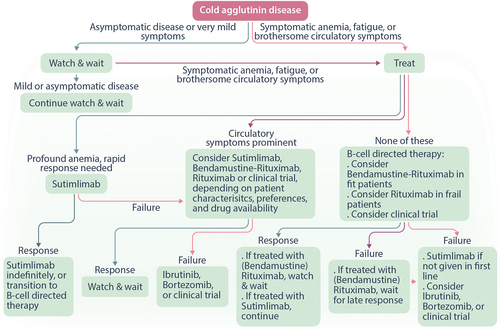
Treatment algorithm for CAD.
ACKNOWLEDGMENTS
The author thanks all colleagues who have performed or contributed to the studies on which this review is based and all patients who have participated in observational studies or prospective trials.
AUTHOR CONTRIBUTIONS
SB collected the information and wrote the article.
DISCLOSURES
Outside this work, SB has received advisory board honoraria from Anexon, Momenta Pharmaceuticals, Sanofi-Genzyme, and Sobi, and lecture honoraria from Apellis, BeiGene, Janssen-Cilag, Sanofi-Genzyme, and Sobi. The author has no conflicts of interest to disclose.
SOURCES OF FUNDING
The author has no sources of funding to declare for this manuscript.



